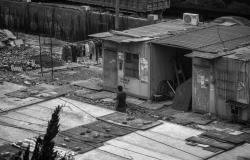Understanding Inequality in China: An Interview with Vamsi Vakulabharanam

Economic inequality is a global phenomenon. And while the data suggests that inequality between countries has fallen, inequality within countries has risen. China, for instance, a country with very low levels of inequality just a few decades ago, now features inequality levels that are comparable to those in the US.
What are the structural mechanisms generating inequality in China since the transition was made from state socialism to market reforms, and what were the sources of equalization during the Mao years? Is China equipped to weather the storm of US tariffs? Political economist Vamsi Vakulabharanam sheds light on these questions in the interview that follows. Vakulabharanam is Associate Professor of Economics and Co-Director of the Asian Political Economy Program at the Political Economy Research Institute (PERI) at the University of Massachusetts Amherst. He is the author of the recently published book Class and Inequality in China and India, 1950-2010.
C. J. Polychroniou: Inequality has been on the rise across the globe for several decades although it manifests itself in different ways in different societies and its causes are quite complex. In the United States, however, it is widely acknowledged that economic inequality has risen sharply since the 1980s and that this is largely due to the promotion of neoliberal economic policies. But what about China, which has experienced rapid growth over the past several decades? Inequality has also increased sharply in China even though it is believed that its leadership rejected the neoliberal prescriptions for economic reform. What are the causes underlying the rise of inequality in China?
Vamsi Vakulabharanam: Global economic inequality (focusing on economic inequality among all the individuals in the world) has two components – economic inequality within countries and economic inequality between countries. Since the 1980s, after neoliberal economic reforms were introduced across the world, there has been a consistent increase in within-country inequality, barring very few exceptions for brief periods (e.g. the pink tide in Latin America). Economic inequality between countries has tended to decrease marginally because of the fast-paced growth in populous countries like China and India. Both these countries have witnessed rapid economic growth between the 1980s and 2010s, even as they have become more unequal internally. What this has done is to catapult a small proportion of the Chinese and Indian elites (capitalists, professional classes and political elites) into the global middle and upper classes during the same period, where these select groups have witnessed significant convergence with their counterparts in the developed capitalist world.
In China, the economic reforms initiated after 1978 tended to reduce inequality until the mid-1980s. This is because the initial reforms were focused on agriculture and in creating special economic zones (e.g., Shenzhen) that led to rapid economic growth in sectors and regions that had witnessed slower growth in the previous three decades. At the same time, the rural non-agricultural sector (e.g., Township and Village Enterprises) grew rapidly and contributed significantly to a spurt in exports from China during the 1980s. After 1985, when the coastal development strategy was initiated, within-country inequality began to rise in China. This increase in inequality had two major sources. The coastal region (and river delta regions) tended to grow faster compared to the central and western regions, thereby creating a trend of rising regional inequality. At the same time, as the urban sector started growing faster than its rural counterpart, there was a rapid growth in the gap between urban and rural areas. These two processes started by the early 1990s to push up the inequality rates up in China.
After 1992 and until about 2007, inequality in China rose continuously, partly due to the continued increase in the urban-rural gap and regional inequalities (the latter roughly until about 2000). However, new processes were added during this period to those that were already heightening inequalities. Despite the popular conception that China did not adopt neoliberal economic policies, the distinctive experience of China rests on two grounds. First, the economic reforms were implemented gradually as opposed to the Russian experience, although most of the prescriptions of the Washington Consensus were implemented in China not in one shot but over time (indeed, scholars like David Harvey have pointed out that growth in China can be described as neoliberalism with Chinese characteristics).
Second, China has maintained a mixed-ownership (in terms of productive resources other than land) economy, although the state-owned enterprise sector (SOE) has a smaller proportion now as the private sector operations have grown over time. There was a significant privatization of SOEs around the turn of the century. They also contributed to a smaller share of total employment over time, partly due to the rapid growth of the private sector but also because state owned enterprises engaged in large scale retrenchments during this period (between 1995 and 2002, over 50 million workers were retrenched in China). The rising inequality process after 1992, therefore, incorporated a new dimension. In urban areas, inequality among classes started to rise. This was, in part, because millions of migrants entered cities to work in manufacturing and in the informal sector after 1992 (without a change in their residency status from rural hukou to an urban one). The distance between some original urban constituents and the migrants tended to increase during this period, while there was higher competition for jobs at the lower end between migrants and some of the older urban residents (e.g., the retrenched workers). There was a faster growth of incomes for the urban elites such as owners, managers, professionals and political elites compared to the rest of the urban population such as older urban workers and migrant workers who had moved from rural to urban areas. This new dimension, Class, is what I focus on in my new book Class and Inequality in China and India, 1950-2010. By the early 2000s, income inequality in China (even without including high net worth individuals in the sample) has tended to be as high as it is in the US. Wealth inequality has also risen rapidly in China during this period and has tended to equal wealth inequality levels in the capitalist Global North.
From the mid-2000s onwards, inequality in China has remained at high levels although it has tended to stagnate or mildly reduced. There are many factors that are causing this outcome but let me highlight a few here. First, around 2007, the coastal regions witnessed labor shortages, so wages showed an upward tendency, causing some equalization in incomes. This was also the period when some economists began to speculate that the Chinese economy was witnessing a Kuznets moment of transformation in inequality dynamics. Simon Kuznets (Nobel prize winner in economics) had hypothesized in 1955 that within-country inequality in capitalist countries would rise at low levels of per capita income and then tend to decline at higher levels of per capita income. Whether it was a Kuznets-like moment or not, economic activity began to shift to the central and western regions, applying a downward pressure on regional inequalities as well. Second, the Chinese state initiated a new set of welfare-oriented policy reforms that did not go very far but addressed the urban-rural gap and the gap between urban populations and the migrants. While this was by no means revolutionary, it put brakes on the rising inequality process.
All in all, there were four periods after the 1978 economic reforms during which China witnessed very different sets of inequality dynamics. Between 1978 and 1985, it witnessed a reduction in inequality. During the 1985-92 period, inequality tended to rise. Between 1992 and mid-2000s, inequality rose precipitously. Post-2007, inequality has tended to stagnate but is still comparable to inequality levels in the US.
C.J. Polychroniou: Was there inequality in China prior to the initiation of economic reforms and trade liberalization? In other words, what is the socialist legacy in China regarding inequality?
Vamsi Vakulabharanam: The socialist legacy regarding inequality is that there was a significant equalization of incomes and wealth between 1949 and 1978. There were four sources of equalization, and three sources of inequality during this period, with the former dominating over the latter for the entire Mao era. While precise data is not forthcoming for this period, the structural evidence is overwhelming, pointing to this conclusion.
The four sources of equalization were the following: (1) Private wealth was largely eliminated; (2) in units like communes or state-owned enterprises enhanced equality; (3) regional inequality was reduced (inter-provincial inequalities went down); and (4) there was significant equalization of access to health care and education.
The first source of equalization is the elimination of private wealth. In rural areas, large scale land reforms were implemented in 1952, and the collectivization of land was successfully completed by 1956. This meant that rural land was owned collectively by village communes. In urban areas, land was owned by the socialist state, so private landownership was largely eliminated. By the 1950s, productive enterprises were largely owned by the state (State Owned Enterprises (SOEs) or the collectives, so private property (save minor assets) was largely eliminated in rural as well as urban areas.
The second source of equalization was the creation of income equality in local units such as communes or state-owned enterprises. This is a case of within-unit equalization in rural areas, which kept open the possibility of between-unit inequality across the country. In urban spaces, within productive enterprises, wage differences were brought to a minimal level by the 1950s. In fact, the Gini Coefficient for urban areas in 1978, when survey-based income data is again available from the National Bureau of Statistics, was below 0.2. China was among the most equal urban spaces in the whole world at that time.
The third source of equalization was in terms of reducing regional disparities. During the Mao period, there was a conscious policy effort to eliminate regional inequalities. This was implemented by relocating productive activity (industrial) to inner provinces away from the more affluent coastal provinces. This process brought about significant levels of provincial equalization, which is reversed in the post-1980s period.
The fourth source of equalization was in terms of education and health care. China expended its resources to implement universal elementary and school education from the very inception of the socialist state. This was in sharp contrast to the Indian development experience, wherein scarce resources were significantly divided between the elites and the large population that was without any formal education. In terms of health care too, China was able to provide universal, high-quality care to its urban population typically through employment-based health care programs. In rural areas, peasants were trained to provide primary health care, and this is how the famous institution of “barefoot doctors” was created.
However, there were broadly three kinds of inequalities that continued. These were (1) between-commune inequalities in rural areas; (2) urban-rural gaps; and (3) political and ideological inequalities. First, in terms of the between-commune inequalities, the main source of the differences across communes came from fertility differences, ecological differences and historical differences. This meant that rural income inequality remained high in China despite the elimination of private wealth, and it was much higher than urban inequality during the Mao period. Second, there was a significant and persistent gap in urban and rural incomes, with a significant deterioration occurring during tumultuous periods, such during the Great Leap Forward campaign and in the aftermath of the Cultural Revolution. The urban population was kept under check and rural migrants were not allowed into cities. Rural populations also had restrictions on intra-rural population and were largely confined to particular villages and communes. Rural populations had lower incomes than their urban counterparts despite the claim of the state being a peasant-based state. This conclusion can be reached by comparing income data from some communes and workers’ wages in cities and the 1978 data once it was made available on a larger scale. Third, there were power and status differences between party leaders and the rest of the population at all levels. These differences may or may not have translated to the economic domain, but they were important markers of non-economic inequalities in everyday life of this period.
In sum, economic and erstwhile political elites were eliminated. Private wealth was eliminated. Within-unit economic equality was established in rural units. Urban equality was implemented across the country, along with educational and health equities. While some inequalities remained, the overall dominant trend during the whole socialist period (or what has been termed the Mao period between 1949 and 1978) was one of greater equality.
C. J. Polychroniou: The Chinese economic model in place since the late 1970s is called a market socialist economy. Is that an accurate description? I mean, is it possible for an economy to be socialist if it has a stock market?
Vamsi Vakulabharanam: This is an interesting question. In my own understanding, there are two phases in the evolution of the Chinese economy after 1978. The first phase is between 1978 and the early 1990s. This is the phase that Giovanni Arrighi emphasized in his book Adam Smith in Beijing, where he argues that Chinese reforms largely ushered in markets but did not engage in processes of accumulation by dispossession, whereby people are stripped of their productive assets leaving them with nothing but their ability to perform labor. I could see people making a case for China being market socialist during that period.
My criticism of Arrighi is that in the post-1992 period, there was significant retrenchment of workers as mentioned above but, in addition, land dispossession processes occurred at a rapid pace to pave the way for private sector manufacturing and infrastructure (e.g., three gorges dam). A lot of migrant workers that moved from rural areas to urban areas were dispossessed of their means of production in their villages, and many of them today have no villages to return to while possessing no major assets where they currently live, including housing in urban areas. Overall, a significant majority of the workforce in urban areas works for the private sector now. According to surveys in major cities, close to half the urban workforce is engaged in informal work. The private sector in China is largely indistinguishable from the private sector in the capitalist world in the sense that its profitability is based on a capitalist mode of exploitation of workers. The Chinese state has retained ownership and control over some key sectors such as telecommunications, energy (e.g., petroleum and electric power), military equipment and infrastructure (e.g., railroads). Many SOEs in today’s China also function on broad capitalist principles. In any case, the private sector is the dominant one in the overall Chinese economy. The state may have greater leeway over the private sector, especially after 2012, compared to the immediately preceding period inside the country and compared to other capitalist countries, but it is unmistakable that the larger economy is governed by capitalist dynamics. I would characterize the current Chinese economy as a mixed-ownership capitalist economy, not a market-socialist one.
C. J. Polychroniou: What is the stance of the Chinese Communist Party on inequality? Does it take economic inequality and hence wealth redistribution seriously?
Vamsi Vakulabharanam: The official stance of the Chinese Communist Party on inequality has not changed since the time of reforms. Deng Xiaoping’s Let some people and some regions get rich first dictum affords a certain freedom-in-the-concrete for experimenting with policies that are deeply capitalist in nature. The real question is whether the emergence and entrenchment of capitalist class structures in the larger society changes the complexion of that dictum and creates a new one – in order to help those that did not get rich first, let there be another people’s revolution. Since the party is inspired by Marx, I am sure that its leaders are not unaware of the fact that the economic processes they have unleashed perpetuate class-based inequalities.
The real history of the Chinese economy and society after the initiation of the economic reforms, and especially after 1992, would indicate that the party turned a blind eye to issues of economic inequality in the interests of economic growth. It is true that the overall GDP of the Chinese economy has risen dramatically since the reforms and that different classes have improved their economic conditions more rapidly than they did during the socialist period. However, some classes (such as the urban elites, as I show in my book) have witnessed significantly sharper increases in their incomes and wealth holdings and have become deeply entrenched in their class positions. China has more dollar billionaires (814) than the US (800), according to the 2024 Hurun rich list. At the same time, more than 250 million internal migrants have no significant assets or even hukou in urban areas, while they are allowed to work in cities by the Chinese state. In a significant number of these cases, their village entitlements may have been eroded by the expanding urban spaces. This sort of a gap could not have arisen if the Chinese state was committed to egalitarianism, even with some leeway for a dictum like some inequality is acceptable if the overall economy achieves significant growth.
The Chinese Communist Party must rediscover egalitarianism in the deeply unequal society that China has turned into after the market reforms of 1978.
C. J. Polychroniou: The Trump administration has backed down from its disastrous trade war with China, but there is no doubt that tensions are still simmering. How would the trade war affect China's economy?
Vamsi Vakulabharanam: I am not a trade economist, but there are some obvious implications that everybody is aware of. Tariff hikes by the US will, in the short-term, lead to reductions in Chinese exports to the US and will increase unemployment in export-oriented sectors. Since China has imposed retaliatory tariffs, this will lead to price increases in those sectors in which China imports US goods. I show in my book that China and India still have a very unfavorable unequal exchange with the US, and these tariffs will worsen that condition even more. China may lose some more surplus value to the US in this new situation. However, China has considerable leverage in its trade relations with the US and is using it, which is the reason why the Trump administration backed down.
The Chinese state and the party are strategic entities and deeply responsive to changes in the global economy. In the medium-run, I expect the Chinese state to redirect its exports to other parts of the world and continue its economic journey without too many hiccups.
What is interesting to see is whether this trade war heightens the awakening of the party to address the inequalities inside the country that we have discussed here. That is another route that China can take to reduce its dependence on the US and other developed countries, with which it has an unfavorable labor value exchange, even now, in international trade. In general, the main response of China after the global crisis of 2008 has been to externalize its internal contradictions (e.g., inequality) by focusing on the Belt and Road Initiative (BRI) initiative. The aim behind the BRI initiative is for China to expand its global presence but also to provide an outlet to the crises of Chinese capitalism.
Perhaps this is the opportunity for the party to deeply rethink the future trajectory of the Chinese society, and particularly its deeply unequal nature. It is by no means an easy task because China now has deeply entrenched class structures.
C.J. Polychroniou is a political scientist/political economist, author, and journalist who has taught and worked in numerous universities and research centers in Europe and the United States. Currently, his main research interests are in U.S. politics and the political economy of the United States, European economic integration, globalization, climate change and environmental economics, and the deconstruction of neoliberalism’s politico-economic project. He is a columnist for Global Policy Journal and a regular contributor to Truthout as well as a member of Truthout’s Public Intellectual Project. He has published scores of books and over one thousand articles which have appeared in a variety of journals, magazines, newspapers and popular news websites. Many of his publications have been translated into a multitude of different languages, including Arabic, Chinese, Croatian, Dutch, French, German, Greek, Italian, Japanese, Portuguese, Russian, Spanish, and Turkish. His latest books are Optimism Over Despair: Noam Chomsky On Capitalism, Empire, and Social Change (2017); Climate Crisis and the Global Green New Deal: The Political Economy of Saving the Planet (with Noam Chomsky and Robert Pollin as primary authors, 2020); The Precipice: Neoliberalism, the Pandemic, and the Urgent Need for Radical Change (an anthology of interviews with Noam Chomsky, 2021); and Economics and the Left: Interviews with Progressive Economists (2021).
Photo by Zekai Zhu


